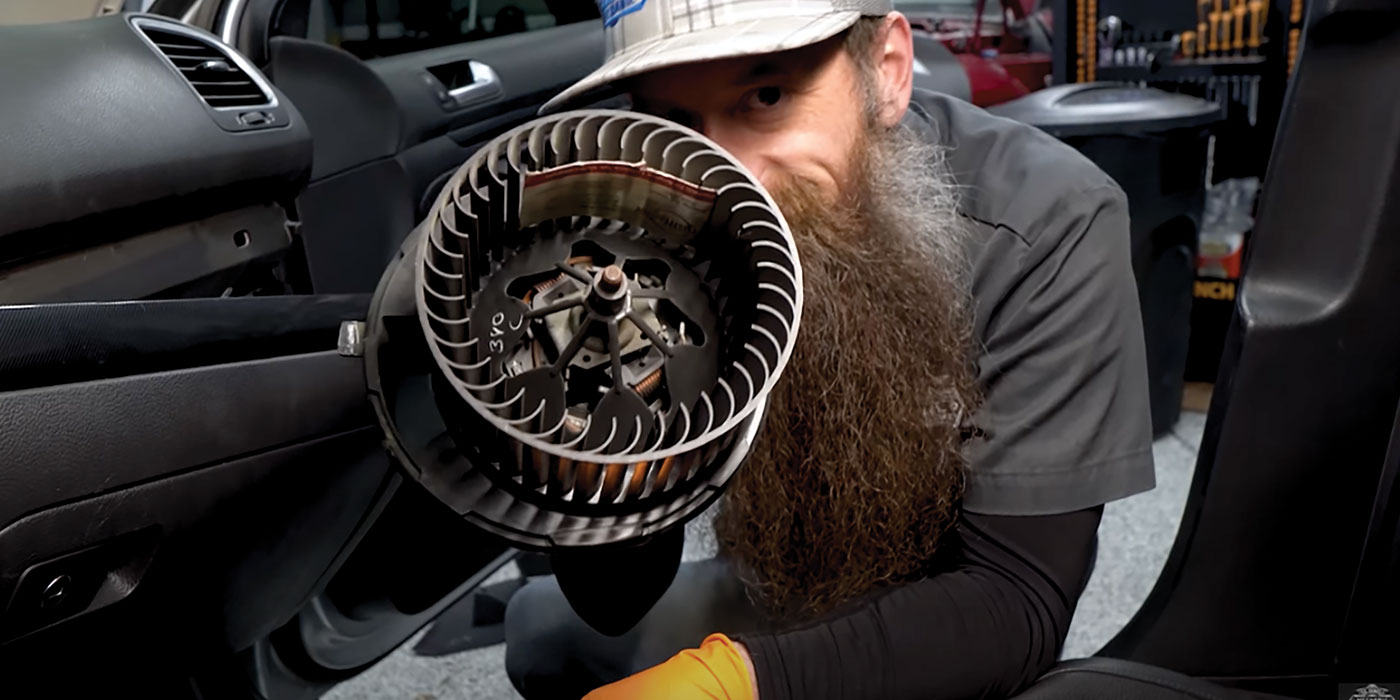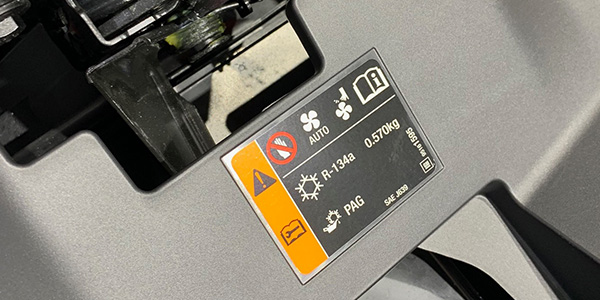Volvo engines have always been noted for their durability and long-term, trouble-free operation. But just like any internal combustion engine, they could develop head gasket problems that stem from owner neglect or the engine design. This article will detail the diagnostic process and procedures for replacing the head gasket in the most common Volvo engine – the B230F engine – which is one of the basic four-cylinder engines that was produced until 1995 in the 240/740/940 body styles. When the head gasket developed a leak in that particular engine, it was caused primarily by the vehicle’s age or a troubled cooling system. The cylinder head is aluminum and, while it saves weight, it expands 1.5 times faster than the cast-iron block.
Engine Design Issues
Distortion and warping are common problems with aluminum cylinder heads because of a combination of the very high thermal conductivity of aluminum, the fact that the head is thinner and smaller than the block, and the physical law that heat rises. This expansion rate will induce motion and scrubbing between the head and block, and eventually cause a leak.
Scrubbing is a common problem in a bi-metal engine, where two different metals are used for the cylinder head and engine block. The scrubbing action causes abrasion and shearing to the head gasket, which results in failure. Following the correct head bolt tightening sequence and applying the proper torque will help to minimize this effect.
Volvo uses a graphite head gasket because graphite has natural lubrication that can handle the differences in temperature between the aluminum head and the cast-iron block. Graphite is a very soft material that provides good sealing when cold and it can withstand very high temperatures. The head gasket must seal combustion pressures up to 1,000 psi, as well as withstand temperatures in excess of 2,000° F. Required to withstand this severe environment, the slightest fault in a gasket will eventually lead to failure.
Sealing Precautions
For the head gasket to seal properly, the cylinder head and the engine block must be inspected for flatness. Place a straightedge lengthwise on the block and then the head. Check with a feeler gauge for warping between the surface and the straightedge. The total maximum amount of combined clearance between the head and block should not exceed 0.004”. Don’t forget to check it crosswise (also should not exceed 0.004”).
A proper surface finish is also very important for the head gasket to provide a quality seal. If the surface is too smooth, it might not provide a good grip to hold the gasket in place. And, although a rougher surface provides more grip, it also will cause abrasion and deterioration as the combination (head and block) expands and contracts from the extreme changes in temperatures. Not only does the head gasket seal high-compression cylinder pressures, it also seals coolant passages and oil feed galleries that lubricate upper valve areas.
Tactical Tips
The first step is to clean the head of all grease, oil and carbon before inspection. Cracks can be found around the exhaust seats where they are pressed in the head.
Most of the time, you can leave the valves in the head, but pull off the camshaft. If there is any suspicion of overheating, it is a good idea to perform a valve job and install new seals at that time. When the cylinder head is dropped off from the machine shop, blow out all the oil passages and bolt holes with compressed air to remove any tiny fillings that could lodge in the oil pump pressure regulator valve, causing catastrophic failure.
Note: The engine block can be belt-sanded, or you can use a Jidder bug with 60-grit paper and (very carefully) try to move the sander all over, not stopping at one area. Never use abrasive pads to buzz off the old gaskets, as they can leave low spots on the sealing surface that the head gasket may not be able to fill. Never use any type of sealant on the head gasket to keep it dry. Some sealers will break down the gasket, causing leakage and possible comebacks from unhappy customers over a period of time.
The head bolts are often overlooked, so I recommend replacing the head bolts when the cylinder head is removed for any reason. The B230 engine has torque-to-yield bolts (TTY) and the B5254 engine also uses them. TTY bolts are essentially stretch bolts that produce more clamping force on the cylinder head for proper sealing of the head gasket.
Head Examination
Perform a leak-down test. It provides a lot of information about the condition of the engine. Check for bubbles in the expansion tank.
While the engine is running, hold an exhaust analyzer close to the coolant expansion tank to obtain a reading.
Pressurize the cooling system and crank over the engine. Look for coolant leakage in the cylinders.
Check the spark plugs for a green tinge on the electrode.
Add dye to the oil to detect small leaks between the head and the block under the manifolds.
Properly diagnose the source of the gasket failure, since it must be corrected before or during the replacement procedure. Otherwise, the replacement gasket will fail from the same problem.
Check the cooling system, water pump, radiator, hoses and cooling fan operation. Thermostat stuck? On the Volvo 850, don’t forget to check the cooling fan and the relay, as they tend to work erratically at times. The 240 Series uses a clutch fan with the electric fan for the A/C. Do not overlook that area.
Removal Recommendations When removing the B230 cylinder head: 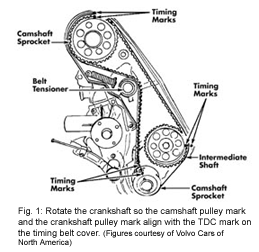
Drain the cooling system at the radiator and the block, disconnect the negative battery cable and remove the intake manifold and exhaust manifold (discard the old manifold lock nut
Remove all drive belts and the water pump pulley. Remove the fan, preheater hose, and fan shroud and timing belt cover.
Using the center bolt on the crankshaft, rotate the crankshaft so the mark on camshaft pulley aligns with the TDC mark on the timing belt cover, and the crankshaft pulley mark aligns with TDC mark on timing belt cover (see Figure 1). 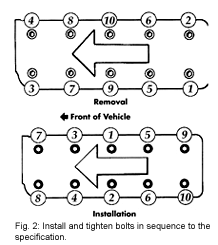
Loosen the belt tensioner nut one turn. Pull off the timing belt to compress the belt tensioner spring. Tighten the belt tensioner nut. Then install a 3 mm drill bit in the hole of the belt tensioner bolt to lock the tensioner spring into place.
This might be a good time to replace that worn-out belt. If not, mark the belt with the camshaft sprocket, using typing correction fluid to ease installation.
Remove the spark plug wires and distributor cap. Remove the cylinder bolts in the proper sequence and remove the cylinder head (see Figure 2). Volvo recommends replacing the head bolts if they are stretched or used more than five times. As mentioned earlier, when in doubt, replace them!
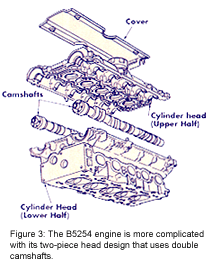 Putting It Back Together
Putting It Back Together
Ensure that the camshaft is positioned so that the valves are closed on the No. 1 cylinder and the No. 1 piston is at TDC. Install the new head gasket with top marked upward (and don’t use sealant!). Ensure that the O-ring for the water pump sits correctly in the groove (this is a good time to replace the water pump). Install the cylinder head.
Apply a light coat of oil on the new head bolts before installation. Install and tighten bolts in sequence to the specification using the three stages (also see Figure 2). Start at 14 ft.-lbs., then go to 43 ft.-lbs., then go an additional 90°.
Note: The B5254 engine is more complicated with its two-piece head design that uses double camshafts and an aluminum engine block (see Figure 3). That engine is an interference engine. The only time we had to remove the cylinder head in that particular type of engine was when the timing belt failed and caused catastrophic failure.





